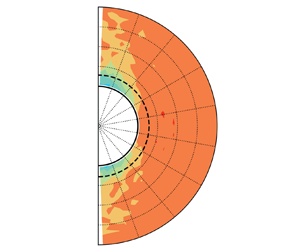Article contents
Particle–particle drag force in inertial bidisperse gas–particle suspensions
Published online by Cambridge University Press: 23 November 2022
Abstract

Particle-resolved direct numerical simulations are employed to investigate the particle–particle drag force in the bidisperse gas–particle suspensions where the particles are smooth and the single-particle velocity distribution function is Maxwellian. The particle Reynolds number ranges from 6.7 to 123.8, and in this range the particle inertia is high enough that the lubrication force is not essential. It is found that the relation derived by the kinetic theory of granular flow (KTGF) highly overestimates the particle–particle drag force. This is because the pre-collision velocities of colliding particles are not completely uncorrelated with each other. From the time sequence of collision events, it is observed that the particle pair that has just collided will probably collide again after a short time due to the restriction of the particle motion in dense suspensions. Since the post-collision velocities of the first collision cannot relax entirely in such a short time, the relative velocity before the subsequent collision is statistically smaller than the domain-averaged relative velocity. Consequently, the particle–particle drag force is over-predicted when the domain-averaged relative velocity is used. For this reason, this work assumes that the particle–particle drag force is determined by the relative velocity within a local region near large particles. When the local region is set to be the spherical shells centred on the centres of large particles and with an outer radius of a mean free path of small particles, the KTGF-based relation can reasonably predict the particle–particle drag force.
- Type
- JFM Papers
- Information
- Copyright
- © The Author(s), 2022. Published by Cambridge University Press
References
- 1
- Cited by



